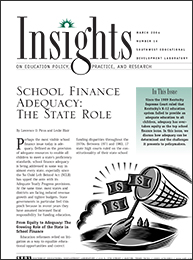School Finance Adequacy: The State Role
School Finance Aqequacy: The State Role
In This Issue
Since the 1989 Kentucky Supreme Court ruled that Kentucky's K-12 education system failed to provide an adequate education to all children, adequacy has overtaken equity as the top school finance issue. In this issue, we discuss how adequacy can be determined and the challenges it presents to policymakers.
Introduction

Perhaps the most visible school finance issue today is adequacy. Defined as the provision of adequate resources to enable all children to meet a state's proficiency standards, school finance adequacy is being addressed in some way in almost every state, especially since the No Child Left Behind Act (NCLB) has upped the ante with its Adequate Yearly Progress provisions. At the same time, most states and districts are facing reduced revenue growth and tighter budgets. State governments in particular feel this pinch because in recent years they have assumed increased fiscal responsibility for funding education.
Next Page: From Equity to Adequacy: The Growing Role of the State in School Finance

